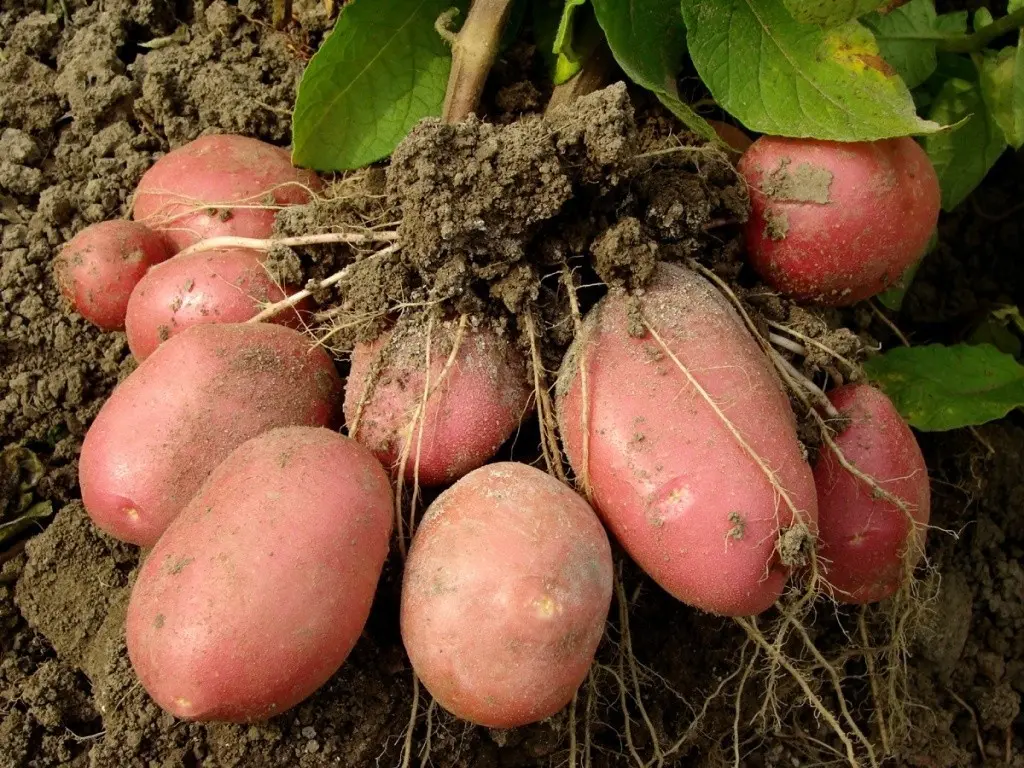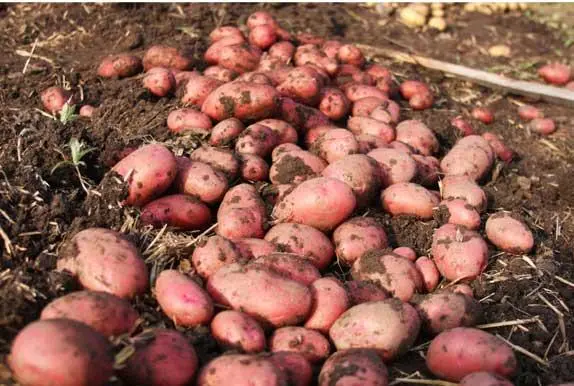Contents
Rosara potatoes, bred in Germany, are well known to large agricultural enterprises and individual gardeners. This variety grows well in mid-latitude conditions and gives high yields. Below we will consider in detail the description of this crop and describe all the features of care and cultivation.
Variety description

A distinctive feature of the Rosara variety is the color of the tubers. The peel is colored in light or dark red. The flesh has a characteristic light yellow color. The average weight of a potato is 85 to 115 grams. Tubers have an oblong oval shape. The ground part of the plant is a semi-spreading bush of medium size with erect stems. The flowers are reddish-purple.
Potatoes are widely used in industrial processing for the manufacture of dried raw materials. The variety contains a fairly low percentage of starch – 12-15%. Due to this, the potatoes do not boil soft during cooking and hold their shape. According to consumers, Rosara is best used for soups, stews and salads. It is not recommended to use this variety for frying.

The productivity of the culture is kept at the level of 12-15 tubers from 1 bush. At the same time, almost all potatoes reach the same size. From 1 acre of land, you can collect about 350-400 kilograms. With special care, the indicators increase to 500 kilograms. One of the most important characteristics of the variety is that the Rosara potato gives stable yields for 4-5 seasons without updating the seed fund.
Mature potatoes perfectly tolerate transportation and winter storage.
According to the description of agricultural specialists, the variety is resistant to golden nematode, Yn virus and potato cancer. A high degree of resistance of the variety is noted to late blight and scab. The culture reacts somewhat worse to virus X. Leaf curl is not observed.
Also in the description it should be noted that Rosara is classified as an early ultra-ripe variety. The formation of the final crop takes from 65 to 75 days. When planting seeds in the ground in the second half of May, harvesting is planned for the end of August.
Video “The best varieties of potatoes”
Cultivation and care
Initially, the Rosara variety was intended for cultivation in the Middle Volga and Central Black Earth regions, although, as practice shows, the culture adapts well to different climatic conditions. Rosara is classified as an unpretentious variety, but for high yields, attention must be paid to all aspects.
First of all, you need to properly prepare the soil. Best of all, the plant perceives light sandy and loamy soils. Ideally, the soil should have a uniform structure without coarse clods in order to retain the required amount of water and prevent waterlogging. Potatoes grow better on soils after legumes, pumpkins, corn, cucumbers and cabbage. It is not recommended to plant Rosara in areas after sunflower, sorghum and nightshade crops (tomatoes, eggplants, bell peppers).
Potatoes are a light-loving plant, so choose well-lit places. Before planting seed tubers of the Rosara variety, the soil must be fertilized. In autumn, it is recommended to apply manure or compost, phosphorus and potassium. Nitrogen fertilizers should be applied in early spring. It is important to prevent hypothermia of the seeds, so the soil is pre-warmed, especially in cold regions. At the beginning of spring, you need to remove a layer of snow from the area for potatoes. After a while, you can start watering with warm water and cover the soil with a black film.

For cultivation, you will need tubers of the Rosara variety weighing from 30 grams. Pay attention to their condition. In no case do not take rotten and spoiled fruits. Germination begins in early March. To do this, the tubers are taken out of the basement into a bright room with a temperature of 15-18 ° C. 2 weeks before planting, germinated seeds are returned to the cellar with a temperature of 4-6 ° C for hardening. For planting, select tubers with thick sprouts. Filamentous sprouts can be damaged. Large potatoes are allowed to be divided in half.
As for the description of the planting process itself, then first you will need to plow the ground to a depth of at least 20 centimeters. Holes are made about 10 centimeters deep. The distance between the holes in the row is 40 centimeters. Row spacing should not be less than 65 centimeters. For best results, a small amount of wood ash mixed with eggshells is sprinkled on the bottom of the hole. Upon completion of planting, the site is watered abundantly.
Further care begins even before the germination of the first sunrises. You need to loosen the soil and remove weeds in time. The variety needs moderate watering, otherwise you risk getting rotten tubers. Hilling is carried out at least 2 times during the entire growth cycle. In dry weather, the Roser variety requires up to 5 liters of water for 1 adult bush. According to the description of experienced gardeners, hilling should not be carried out during hot periods if the stems do not grow anyway.
Video “Potatoes in a warm garden”
The video is useful for those who are going to grow truly elite varieties of potatoes in warm beds. Valery Medvedev gives advice.









